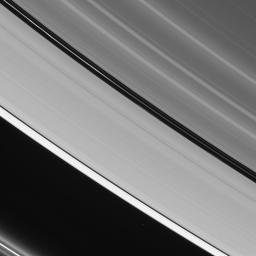The two prominent dark gaps in Saturn's A ring contain small embedded moons and a host of other intriguing features.
Here, three unique ringlets are visible in the Encke gap (325 kilometers, or 200 miles wide). The innermost ringlet (topmost here) is faint but continuous. The center ringlet brightens substantially toward upper left and displays a few slight kinks. This ringlet is coincident with the orbit of Pan (26 kilometers, or 16 miles across). The outermost ringlet is discontinuous, with two bright regions visible.
The narrower Keeler gap (42 kilometers, or 26 miles wide) hosts the moon Daphnis (7 kilometers, or 4.3 miles across, not in this image), which raises waves in the gap edges as it orbits Saturn (see PIA07809).
At lower left, faint ringlets flanking the bright F ring core are visible. These features were found by the Cassini spacecraft to be arranged into a spiral arm structure that winds around the planet like a spring. The spiral may be caused by tiny moonlets or clumps of material that have smashed through the F ring core and liberated material.
This view looks toward the unlit side of the rings from about 23 degrees above the ringplane.
The image was taken in visible red light with the Cassini spacecraft narrow-angle camera on Sept. 11, 2006 at a distance of approximately 1.1 million kilometers (700,000 miles) from Saturn and at a Sun-Saturn-spacecraft, or phase, angle of 151 degrees. Image scale is about 6 kilometers (4 miles) per pixel.
The Cassini-Huygens mission is a cooperative project of NASA, the European Space Agency and the Italian Space Agency. The Jet Propulsion Laboratory, a division of the California Institute of Technology in Pasadena, manages the mission for NASA's Science Mission Directorate, Washington, D.C. The Cassini orbiter and its two onboard cameras were designed, developed and assembled at JPL. The imaging operations center is based at the Space Science Institute in Boulder, Colo.
For more information about the Cassini-Huygens mission visit http://saturn.jpl.nasa.gov/home/index.cfm. The Cassini imaging team homepage is at http://ciclops.org.

 Planetary Data System
Planetary Data System












